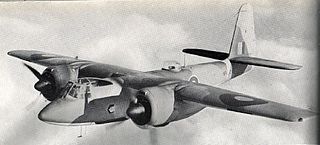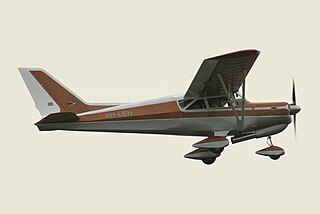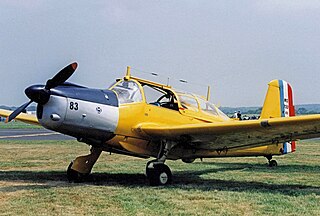Related Research Articles

Auster Aircraft Limited was a British aircraft manufacturer from 1938 to 1961.
Beagle Aircraft Limited was a British light aircraft manufacturer. The company produced the Airedale, Terrier, Beagle 206, Husky and the Pup. It had factories at Rearsby in Leicestershire and Shoreham in Sussex. The company was dissolved in 1969.

The Curtiss-Wright AT-9 Jeep was a twin-engined advanced trainer aircraft used by the United States during World War II to bridge the gap between single-engined trainers and twin-engined combat aircraft. The AT-9 had a low-wing cantilever monoplane configuration, retractable landing gear and was powered by two Lycoming R-680-9 radial engines.
The Gotha Go 244 was a transport aircraft used by the Luftwaffe during World War II.

The PZL.50 Jastrząb (hawk) was a Polish pre-war fighter aircraft design by Wsiewołod Jakimiuk of the PZL works. The single-seat low-wing monoplane was to serve as a multi-purpose fighter and escort to replace all other fighters in the Polish Air Force. Designed after 1936, its prototype first flew in February 1939. A further two prototypes were under construction by the time of the Invasion of Poland, but the fighter never entered mass production.

The Miles M.33 Monitor was a twin-engined British target tug aircraft designed and built by Miles Aircraft towards the end of the Second World War. Intended for use by the Royal Air Force and the Fleet Air Arm, the aircraft did not enter service with either.

The Beagle B.206 is a 1960s British seven-seat twin-piston engined liaison and communication aircraft built by Beagle Aircraft Limited at Shoreham Airport and Rearsby Aerodrome.

The Beagle B.121 Pup is a 1960s British 2–4 seat single-engined training and touring aircraft built by Beagle Aircraft Limited at Shoreham Airport and Rearsby Aerodrome.

The Miles M.28 Mercury was a British aircraft designed to meet the need for a training and communications plane during the Second World War. It was a single-engined monoplane of wooden construction with a twin tail and a tailwheel undercarriage with retractable main units.

The MD-12 was a Polish four-engined short-range passenger and civil utility aircraft of the 1960s, which remained in a prototype stage. The PZL brand is conventional, since it did not enter production, and was referred to under its project designation only.
The PZL.48 Lampart (leopard) was a Polish heavy fighter-bomber design, that remained only a project, owing to the outbreak of World War II.

The Beagle A.109 Airedale is a British light civil aircraft developed in the 1960s.

The Elliotts of Newbury EoN or Elliotts EoN A.P.4 was a 1940s British four-seat touring monoplane aircraft built by Elliotts of Newbury.

The Funk Model B was a 1930s American two-seat cabin monoplane designed by Howard and Joe Funk. Originally built by the Akron Aircraft Company later renamed Funk Aircraft Company.

The Fairchild 22 Model C7 was an American two-seat touring or training monoplane designed and built by the Kreider-Reisner division of the Fairchild Aircraft Corporation at Hagerstown, Maryland.

The PZL-102 Kos (blackbird) is a Polish two-seat touring and training monoplane designed and built by PZL.

The SIAI-Marchetti S.210 was a 1970s Italian twin-engined cabin-monoplane designed and built by SIAI-Marchetti as a development of the single-engined SIAI-Marchetti S.205.

The Wing D-1 Derringer is an American light twin-engined two-seat monoplane tourer designed by John Thorp and developed by the Hi-Shear Corporation and built by the Wing Aircraft Company.

The Morane-Saulnier Alcyon is a two or three-seat basic training monoplane designed and built in France by Morane-Saulnier.
The Auster C6 Atlantic was a British four-seat cabin monoplane designed and built by Auster Aircraft Limited. Development of the type was abandoned after initial flight tests.
References
- Notes
- Sources
- Beagle Aircraft - A Production History. Leicester, UK: Midland Counties Publications. 1974. ISBN 0-904597-00-8.
- Jackson, A.J. (1987). British Civil Aircraft since 1919 Volume 1. London: Putnam. ISBN 0-85177-808-9.
- Taylor, John W. R. (1962). Jane's All The World's Aircraft 1962–63. London: Sampson Low, Marston & Company, Ltd.
- Wenham, Tom (2015). False Dawn - The Beagle Aircraft Story. Air-Britain Publishing. ISBN 978-0-85130-479-3.